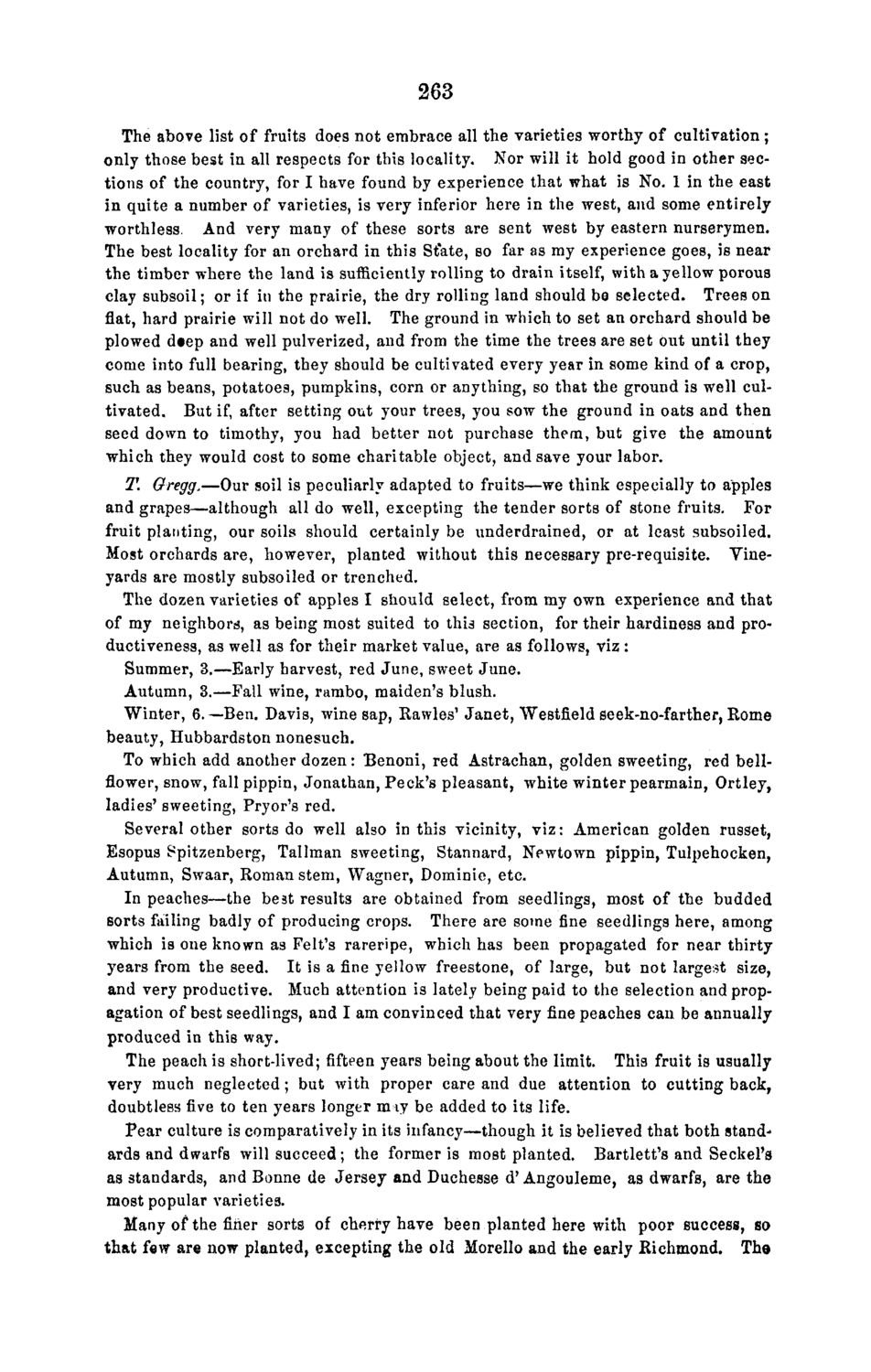| |
| |
Caption: Board of Trustees Minutes - 1868
This is a reduced-resolution page image for fast online browsing.

EXTRACTED TEXT FROM PAGE:
263 The above list of fruits does not embrace all the varieties worthy of cultivation ; only those best in all respects for this locality. Nor will it hold good in other sections of the country, for I have found by experience that what is No. 1 in the east in quite a number of varieties, is very inferior here in the west, and some entirely worthless. And very many of these sorts are sent west by eastern nurserymen. The best locality for an orchard in this St'ate, so far as my experience goes, is near the timber where the land is sufficiently rolling to drain itself, with a yellow porous clay subsoil; or if in the prairie, the dry rolling land should be selected. Trees on flat, hard prairie will not do well. The ground in which to set an orchard should be plowed d#ep and well pulverized, and from the time the trees are set out until they come into full bearing, they should be cultivated every year in some kind of a crop, such as beans, potatoes, pumpkins, corn or anything, so that the ground is well cultivated. But if, after setting out your trees, you sow the ground in oats and then seed down to timothy, you had better not purchase them, but give the amount which they would cost to some charitable object, and save your labor. T. Gregg,—Our soil is peculiarly adapted to fruits—we think especially to apples and grapes—although all do well, excepting the tender sorts of stone fruits. For fruit planting, our soils should certainly be underdrained, or at least subsoiled. Most orchards are, however, planted without this necessary pre-requisite. Vineyards are mostly subsoiled or trenched. The dozen varieties of apples I should select, from my own experience and that of my neighbors, as being most suited to this section, for their hardiness and productiveness, as well as for their market value, are as follows, viz : Summer, 3.—Early harvest, red June, sweet June. Autumn, 3.—Fall wine, rambo, maiden's blush. Winter, 6.—Ben. Davis, wine sap, Rawles' Janet, Westfield seek-no-farther, Rome beauty, Hubbardston nonesuch. To which add another dozen: Benoni, red Astrachan, golden sweeting, red bellflower, snow, fall pippin, Jonathan, Peck's pleasant, white winter pearmain, Ortley, ladies' sweeting, Pryor's red. Several other sorts do well also in this vicinity, viz: American golden russet, Esopus Ppitzenberg, Tallman sweeting, Stannard, Newtown pippin, Tulpehocken, Autumn, Swaar, Roman stem, Wagner, Dominie, etc. In peaches—the best results are obtained from seedlings, most of the budded sorts failing badly of producing crops. There are some fine seedlings here, among which is one known as Felt's rareripe, which has been propagated for near thirty years from the seed. It is a fine yellow freestone, of large, but not largest size, and very productive. Much attention is lately being paid to the selection and propagation of best seedlings, and I am convinced that very fine peaches can be annually produced in this way. The peach is short-lived; fifteen years being about the limit. This fruit is usually very much neglected; but with proper care and due attention to cutting back, doubtless five to ten years longer miy be added to its life. Pear culture is comparatively in its infancy—though it is believed that both standards and dwarfs will succeed; the former is most planted. Bartlett's and Seckel's as standards, and Bonne de Jersey and Duchesse d' Angouleme, as dwarfs, are the most popular varieties. Many of* the finer sorts of cherry have been planted here with poor success, so that few are now planted, excepting the old Morello and the early Richmond. Tho
| |